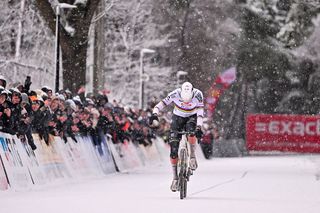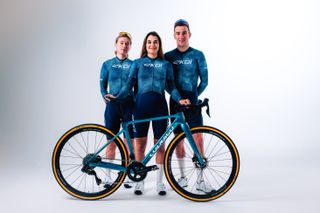Cyclocross
Latest on Cyclocross

'I am very disappointed' – No more cyclo-cross battles with Mathieu van der Poel as Wout van Aert to undergo surgery after crash in Mol
By Laura Weislo last updated
News Van Aert and Van der Poel’s last match of 2026 was due at the UCI Cyclo-cross World Cup in Zonhoven on Sunday

Exact Cross Mol: Mathieu van der Poel conquers snowy conditions to take another victory after Wout van Aert crashes heavily
By Matilda Price last updated
Results Belgian abandoned race after catching world champion but crashing in his wheel, as Aerts and Orts finish on podium

Exact Cross Mol: Ceylin del Carmen Alvarado back to her best in the snow for first victory of the season
By James Moultrie published
Results Dutch rider attacks away from Manon Bakker at the end of lap four, before soloing to the win in wintry conditions

X2O Trofee Baal-GP Sven Nys: Mathieu van der Poel dominates to secure seventh consecutive season win despite crashing in thick mud
By Kirsten Frattini published
Results Emiel Verstrynge takes second after strong performance ahead of Thibau Nys in third on New Year's Day

X2O Trofee Baal-GP Sven Nys: Lucinda Brand secures 13th consecutive season victory in elite women's race
By Kirsten Frattini published
Results Puck Pieterse takes second, Zoe Bäckstedt third in cold and rainy conditions on New Year's Day

'There was no longer a place for me' - Bart Wellens leaves cyclo-cross behind to forge role as sports director for Lotto-Intermarché
By Laura Weislo published
Belgian marks his final race in Diegem as leader of Charles Liègeois Roastery CX team

Team EKOÏ - 'Temporary but fully professional' cyclo-cross team gives new life to three riders
By Laura Weislo published
News Second 'cross team in organisation with Fenix-Deceuninck to run through February

'Wout will never be happy if he has to watch every cyclo-cross race on TV' – Van Aert's coach explains why Belgian star needs to compete in winter despite lack of wins
By Alasdair Fotheringham published
News Small chance remains that Van Aert will race upcoming Cyclo-cross World Championships
The latest race content, interviews, features, reviews and expert buying guides, direct to your inbox!
Latest on Cyclingnews
-
'I am very disappointed' – No more cyclo-cross battles with Mathieu van der Poel as Wout van Aert to undergo surgery after crash in Mol
Van Aert and Van der Poel’s last match of 2026 was due at the UCI Cyclo-cross World Cup in Zonhoven on Sunday -
Exact Cross Mol: Mathieu van der Poel conquers snowy conditions to take another victory after Wout van Aert crashes heavily
Belgian abandoned race after catching world champion but crashing in his wheel, as Aerts and Orts finish on podium -
Exact Cross Mol: Ceylin del Carmen Alvarado back to her best in the snow for first victory of the season
Dutch rider attacks away from Manon Bakker at the end of lap four, before soloing to the win in wintry conditions
-
X2O Trofee Baal-GP Sven Nys: Mathieu van der Poel dominates to secure seventh consecutive season win despite crashing in thick mud
Emiel Verstrynge takes second after strong performance ahead of Thibau Nys in third on New Year's Day -
X2O Trofee Baal-GP Sven Nys: Lucinda Brand secures 13th consecutive season victory in elite women's race
Puck Pieterse takes second, Zoe Bäckstedt third in cold and rainy conditions on New Year's Day -
'There was no longer a place for me' - Bart Wellens leaves cyclo-cross behind to forge role as sports director for Lotto-Intermarché
Belgian marks his final race in Diegem as leader of Charles Liègeois Roastery CX team
-
Team EKOÏ - 'Temporary but fully professional' cyclo-cross team gives new life to three riders
Second 'cross team in organisation with Fenix-Deceuninck to run through February -
'Wout will never be happy if he has to watch every cyclo-cross race on TV' – Van Aert's coach explains why Belgian star needs to compete in winter despite lack of wins
Small chance remains that Van Aert will race upcoming Cyclo-cross World Championships -
Superprestige Diegem: Tibor Del Grosso claims back-to-back victories as rivals Joran Wyseure and Thibau Nys crash in the sand pit
Niels Vandeputte leads series ranking with two rounds to go
-
Superprestige Diegem: Puck Pieterse secures first win of the cyclo-cross season in popular night race
Marie Schreiber takes second, Ceylin del Carmen Alvarado third -
'We went looking for a different star name for our cyclocross' – Why the Gullegem Superprestige tried to get Tadej Pogačar to race in Belgium
'We're an enthusiastic organisation always looking for new things' race organisers tell Sporza -
'This is the last thing I wanted to happen' - Spectator apologises after knocking Mathieu van der Poel off balance during Azencross
Spectator questioned by authorities, organisers announce that no charges will be filed




